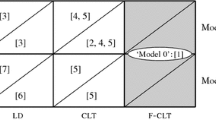Abstract
This paper analyzes large deviation probabilities related to the number of customers in a Markov-modulated infinite-server queue, with state-dependent arrival and service rates. Two specific scalings are studied: in the first, just the arrival rates are linearly scaled by \(N\) (for large \(N\)), whereas in the second in addition the Markovian background process is sped up by a factor \(N^{1+\varepsilon }\), for some \(\varepsilon >0\). In both regimes (transient and stationary) tail probabilities decay essentially exponentially, where the associated decay rate corresponds to that of the probability that the sample mean of i.i.d. Poisson random variables attains an atypical value.
Similar content being viewed by others
References
Blom, J., Mandjes, M.: A large-deviations analysis of Markov-modulated inifinite-server queues. Oper. Res. Lett. 41, 220–225 (2013)
Blom, J., de Turck, K., Mandjes, M.: Rare-event analysis of Markov-modulated infinite-server queues: a Poisson limit. Stoch. Models 29, 463–474 (2013)
Blom, J., de Turck, K., Mandjes, M.: A central limit theorem for Markov-modulated infinite-server queues. In: Proceedings ASMTA 2013, Ghent, Belgium. Lecture Notes in Computer Science (LNCS) Series, vol. 7984, pp. 81–95 (2013)
Blom, J., Kella, O., Mandjes, M., Thorsdottir, H.: Markov-modulated infinite server queues with general service times. Queueing Syst. 76, 403–424 (2014)
Blom, J., Mandjes, M., Thorsdottir, H.: Time-scaling limits for Markov-modulated infinite-server queues. Stoch. Models 29, 112–127 (2013)
D’Auria, B.: M/M/\(\infty \) queues in semi-Markovian random environment. Queueing Syst. 58, 221–237 (2008)
Dembo, A., Zeitouni, O.: Large Deviations Techniques and Applications, 2nd edn. Springer, New York (1998)
de Turck, K., Mandjes, M.: Large deviations of an infinite-server system with a linearly scaled background process. Perform. Eval. 75–76, 36–49 (2014)
Fralix, B., Adan, I.: An infinite-server queue influenced by a semi-Markovian environment. Queueing Syst. 61, 65–84 (2009)
Keilson, J., Servi, L.: The matrix M/M/\(\infty \) system: retrial models and Markov modulated sources. Adv. Appl. Probab. 25, 453–471 (1993)
Norris, J.: Markov Chains. Cambridge University Press, Cambridge (1998)
O’Cinneide, C., Purdue, P.: The M/M/\(\infty \) queue in a random environment. J. Appl. Probab. 23, 175–184 (1986)
Acknowledgments
We thank Rami Atar (Technion) for useful discussions related to the proof of Theorem 1. The work of O. Kella is partially supported by Israel Science Foundation Grant No. 1462/13 and The Vigevani Chair in Statistics.
Author information
Authors and Affiliations
Corresponding author
Additional information
Work done while K. de Turck was visiting Korteweg-de Vries Institute for Mathematics, University of Amsterdam, the Netherlands, with greatly appreciated financial support of Fonds Wetenschappelijk Onderzoek/Research Foundation—Flanders. He is also a Postdoctoral Fellow of the same foundation.
Appendix
Appendix
Represent the elements of the set of combinations of arrival rates and service rates, i.e., \(\{({\mu _i,\lambda _i})\,|\,i\in \{1,\ldots ,d\}\}\), as points in the \(({\mu ,\lambda })\)-plane. Also, we define, for any \(i,j\) such that \(\mu _i\not =\mu _j\),
denoting the slope between the points \(({\mu _i,\lambda _i})\) and \(({\mu _j,\lambda _j})\) in the \(({\mu ,\lambda })\)-plane. Now consider the following algorithm in pseudocode to find \({\varrho }^+\), i.e., the maximum slope between the origin and any \((\mu _i,\lambda _i)\).
Algorithm 1
Input: \(\lambda _i, \mu _i, i\in \{1,\ldots ,d\}\) – Output: k, \(I_0,\ldots , I_k\) and \(i_1,\ldots , i_k\).
-
0.
Set \(\ell :=1, I_0:=0, {\fancyscript{A}}_0:=\{1,\ldots ,d\}\), and
$$\begin{aligned} i_1:=\arg \min \left\{ \mu _i: \lambda _i=\max _{j\in {\fancyscript{A}}_0}\lambda _j\right\} . \end{aligned}$$ -
1.
Let
$$\begin{aligned} {\fancyscript{A}}_\ell :=\left\{ i: I_{\ell -1}<\gamma (i,i_\ell )<\varrho _{i_\ell }\,\mathtt{and}\, \mu _i<\mu _{i_\ell }\right\} . \end{aligned}$$If \({\fancyscript{A}}_\ell \) is empty go to step (3), otherwise, go to step (2).
-
2.
Let
$$\begin{aligned} I_\ell :=\min _{j\in A_\ell }\gamma (j,i_{\ell }),\,\,\,i_{\ell +1}:=\arg \min _{i\in {\fancyscript{A}}_\ell }\left\{ \mu _i:\gamma (i,i_\ell ) =I_\ell \right\} . \end{aligned}$$Set \(\ell :=\ell +1\) and return to step (1).
-
3.
Set \(I_\ell :=\varrho _{i_\ell }\) and STOP.
To aid in understanding, see Fig. 1 for an example with \({d}=7\) and \(k=2\). Note that \(i_1\) is the index of the node with the largest \(\lambda _i\) and \(i_2\) is that of the node with the largest \(\varrho _i\) (\(=\varrho ^+\)). \(I_0\) is the slope zero, \(I_1\) is the slope of the segment connecting \((\mu _{i_1},\lambda _{i_1})\) and \((\mu _{i_2},\lambda _{i_2})\), and \(I_2=\varrho ^+\). Note that in this case there are two indices \(j\) for which \(I{_1}=\gamma (i_1,j)\), and that \(i_2\) is the one having the smaller value of \(\mu _j\). Also note that there is a point (close to (0,0)) that if we connect a segment between it and \(i_2\) the slope is greater than \(I_1\). However, since this slope is also greater than \(\varrho _{i_2}=\varrho ^+\), the algorithm stops at \(\ell =2\). The bold segments describe a concave function, which is the reason why \(\varrho _\ell \), the slopes of the segment connecting \((0,0)\) and \(({\mu _{i_\ell },\lambda _{i_\ell }})\), increases in \(\ell \) and in particular when the algorithm stops then \(\varrho _{i_\ell }=\varrho ^+\). Figure 2 demonstrates that the maximal value of \(\lambda _i-c\mu _i\) is given by \(i_1\) for \(I_0<c<I_1\) and \((\mu _i,\lambda _i) \in [\mu _{i_2},\mu _{i_1}]\times [\lambda _{i_2},\lambda _{i_1}]\) and by \(i_2\) for \(I_1<c<I_2\) and \((\mu _i,\lambda _i) \in [0,\mu _{i_2}]\times [0,\lambda _{i_2}]\).
Algorithm 2
Input: \(\lambda _i, \mu _i, i\in \{1,\ldots ,d\}\) – Output: k, \(I_0,\ldots , I_k\) and \(i_1,\ldots , i_k\).
-
0.
Set \(\ell :=1, I_0:=0, {\fancyscript{A}}_0:=\{1,\ldots ,d\}\), and
$$\begin{aligned} i_1:=\arg \max \left\{ \mu _i:\lambda _i=\min _{j\in {\fancyscript{A}}_0}\lambda _j\right\} . \end{aligned}$$ -
1.
Let
$$\begin{aligned} {\fancyscript{A}}_\ell :=\left\{ i: I_{\ell -1}<\gamma (i,{i_\ell })<\varrho _{i_\ell }\,\mathtt{and}\,\mu _i>\mu _{i_\ell }\right\} . \end{aligned}$$If \({\fancyscript{A}}_\ell \) is empty go to step (3), otherwise, go to step (2).
-
2.
Let
$$\begin{aligned} I_\ell :=\min _{j\in {\fancyscript{A}}_\ell }\gamma (j,i_{\ell })\!,\,\,\, i_{\ell +1}:=\arg \max _{i\in {\fancyscript{A}}_\ell }\left\{ \mu _i:\gamma (i,i_\ell ) =I_\ell \right\} \!. \end{aligned}$$Set \(\ell :=\ell +1\) and return to step (1).
-
3.
Set \(I_\ell :=\varrho _{i_\ell }\) and STOP.
Rights and permissions
About this article
Cite this article
Blom, J., De Turck, K., Kella, O. et al. Tail asymptotics of a Markov-modulated infinite-server queue. Queueing Syst 78, 337–357 (2014). https://doi.org/10.1007/s11134-014-9412-z
Received:
Revised:
Published:
Issue Date:
DOI: https://doi.org/10.1007/s11134-014-9412-z








